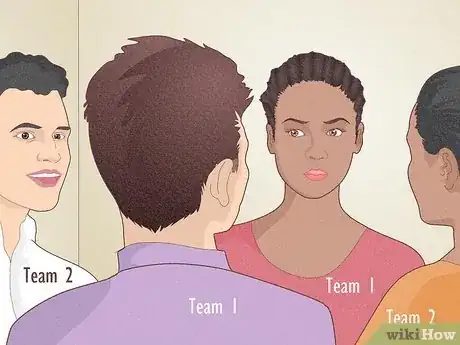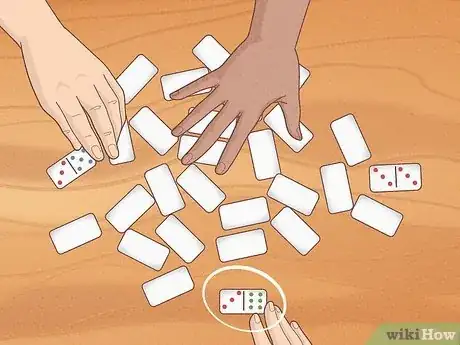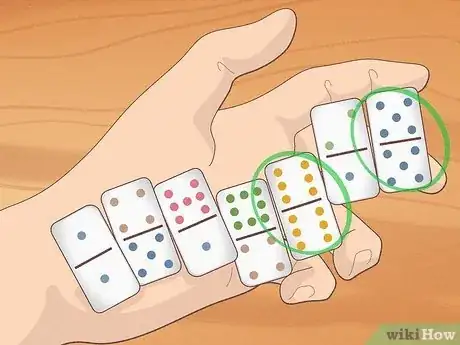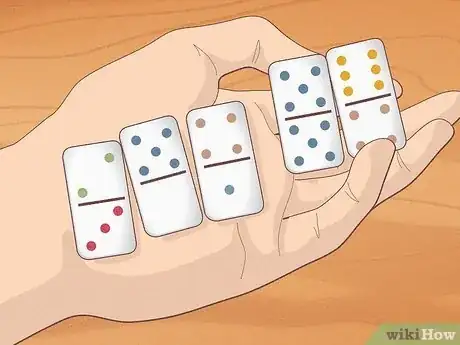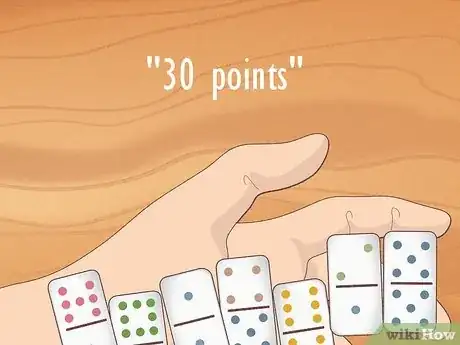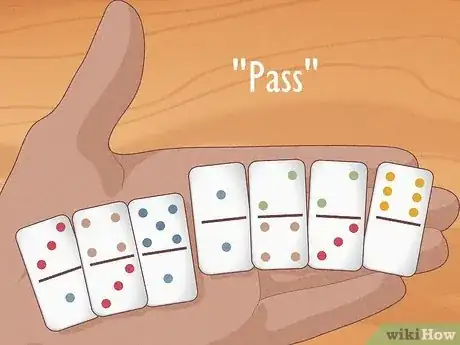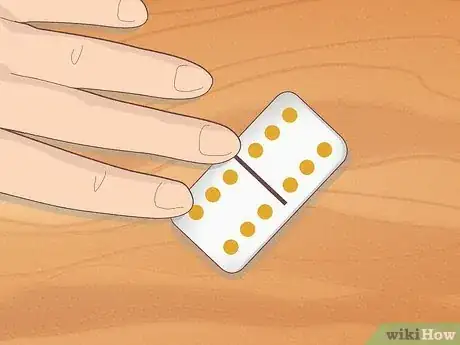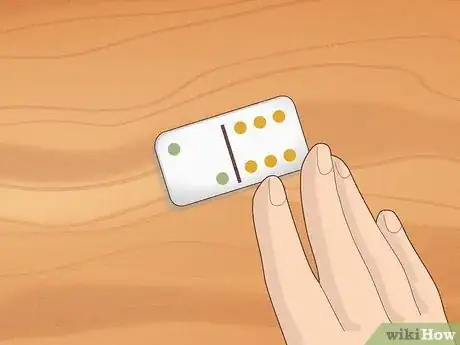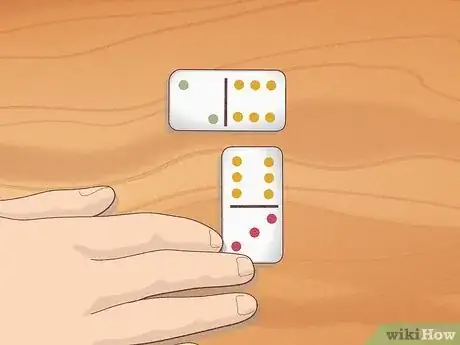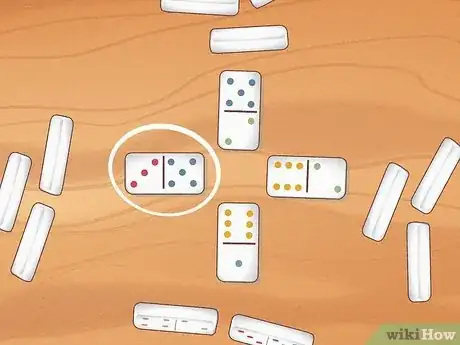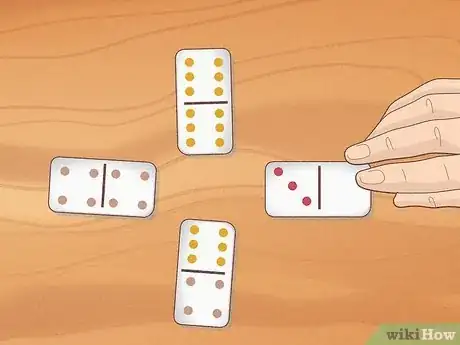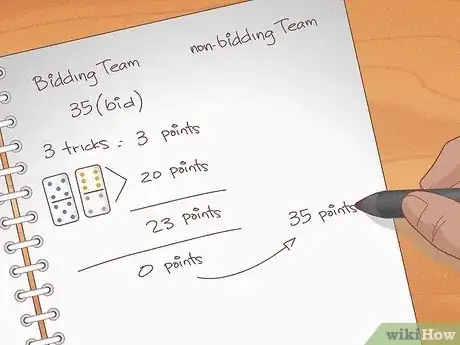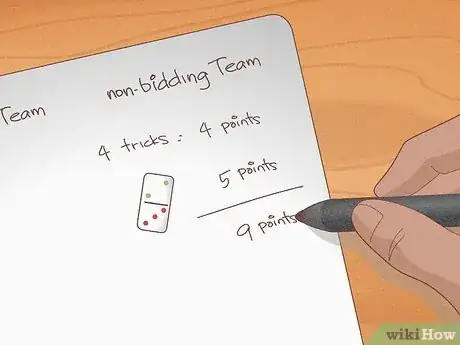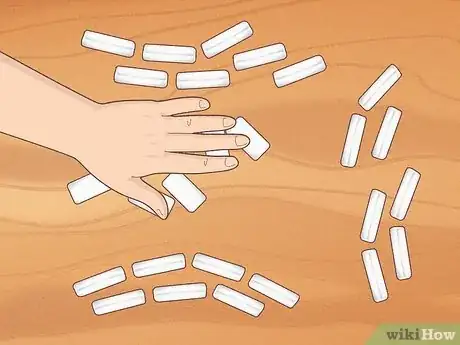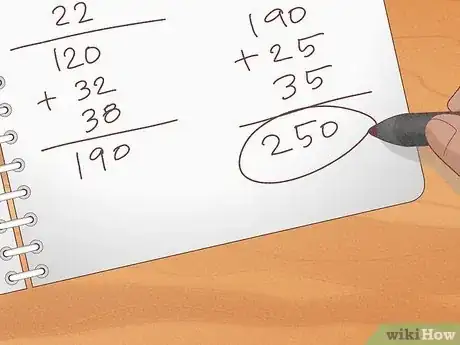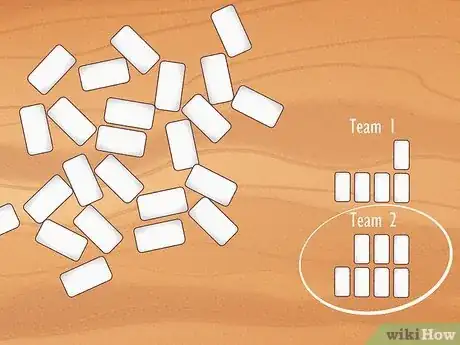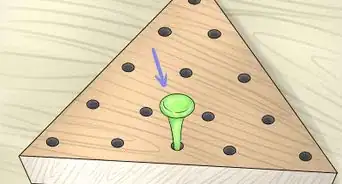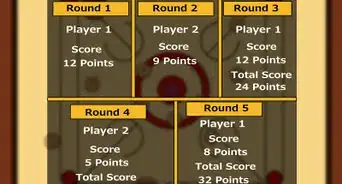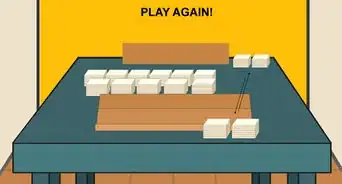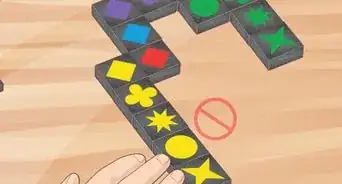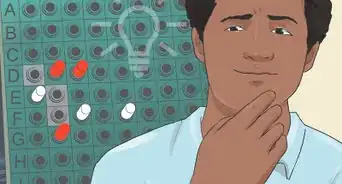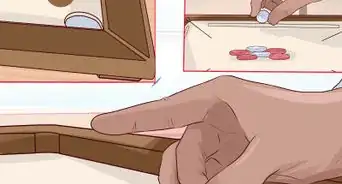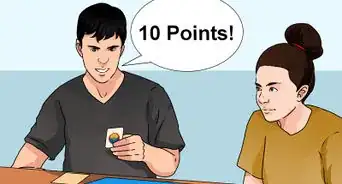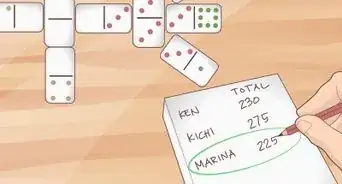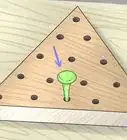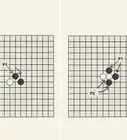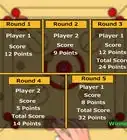This article was co-authored by wikiHow staff writer, Hunter Rising. Hunter Rising is a wikiHow Staff Writer based in Los Angeles. He has more than three years of experience writing for and working with wikiHow. Hunter holds a BFA in Entertainment Design from the University of Wisconsin - Stout and a Minor in English Writing.
There are 10 references cited in this article, which can be found at the bottom of the page.
This article has been viewed 13,080 times.
Learn more...
Are you looking for a fun trick-taking domino game that you can whip out on your next game night? In the game 42, also known as Texas 42 or Four-Hand Texas, teams of two try to earn points by bidding on their hands and playing dominoes. After your team wins 7 hands or is the first to cross 250 points, you win! 42 is easy to learn and teach to your friends, so keep reading for everything you need to know to start playing!
Steps
Setup
-
1Split into 2 teams of 2 players. 42 can only be played with 4 players, so get together with 3 friends and choose a teammate. Sit in a circle around the table so teammates are across from each other.[1]
- Turns will alternate between a member of the first team and a member of the other team.
-
2Draw a domino and choose the first dealer based on the highest value. Lay all 42 dominoes from a double-six domino set face-down on the table and shuffle them.[2] Each player draws 1 domino from the pile and flips it face-up.[3] Count the pips (dots) on each domino. Whoever drew the domino with the most pips starts the game as the dealer.[4]
- You can choose the first dealer randomly if you want to save a little time.
- You can play 42 with a double-nine or double-twelve set as long as you remove any dominoes showing a 7 or higher.
Advertisement -
3
Bidding
-
1Check your hand for doubles and dominoes that share a suit. The domino suits are the values on one side of a domino, so each domino has 2 suits. Double dominoes have the same suit on each side, like 6-6 and 5-5. Doubles are valuable, so having 3 or 4 of them means you have a good hand. If you have 3–4 dominoes with the same suit, that's also a good hand. This means you have a majority of dominoes in that suit, giving you control of it.[7]
- The domino suits rank from high to low going sixes, fives, fours, threes, twos, ones, and blanks (when the side of a domino has 0 pips).[8]
- Even if multiple dominoes share a lower suit, it’s a strong hand since you have the majority of dominoes.
- A trick is when each player plays one domino from their hand to the middle of the table. Each trick is made up of 4 dominoes, 1 from each player. Players have 7 dominoes in their hand, so each round has 7 tricks. Each trick is worth 1 point.
-
2Look for point dominoes in your hand. The 5 dominoes with a total of 5 or 10 pips earn extra points at the end of the round and are called point dominoes. When a player wins the trick they’re played into, the dominoes are worth 5 or 10 points depending on how many pips they have. The total you can earn for collecting all the point dominoes is 35 points.
- The point dominoes worth 5 points are 5-0, 4-1, and 2-3.
- The point dominoes worth 10 points are 5-5 and 6-4.
-
3Place a minimum bid of 30 points if you feel confident in your hand. Bidding starts with the player to the left of the dealer.[9] The player places a bid on how many points they think their team can collectively earn from winning tricks and collecting point dominoes. If another player already made a bid, the next person must make a higher bid than them.[10]
- Players only get 1 bid per round.
- The maximum bid a player can make is 42.
- Players aren’t allowed to communicate what they have in their hands with their teammate.
- Keep bids conservative since a team won’t earn any points if they don’t meet their bid.
-
4Pass the bid if you don’t have a lot of points in your hand. If a player has a lot of low-valued dominoes in their hand or dominoes of different suits, they can say “pass” instead of bidding. Players can also pass if they don’t want to raise the bid any higher since it could make it tougher to compete for points.[11]
- If everyone passes without making a bid, reshuffle the dominoes and deal them again.[12] Or, as an alternate variation, the dealer must bid 30 points if everyone passes.
- If a teammate passes, it’s a signal they have a bad hand and that you should only bid if you have points showing in your hand.
-
5Have the highest bidder choose a trump suit. The highest bidder checks their hand for the suit they have the most of and says it out loud to the rest of the table so they know what the trump suit is for the hand.[13]
- The trump suit acts as the highest suit for the current hand and will beat any other suits played during a trick.
- The player can claim doubles as a suit when choosing trump. 6-6 becomes the highest-valued domino for the round.
Playing a Hand
-
1Start the first trick with the highest bidder. The highest bidder chooses a domino from their hand and places it in the center. The lead suit is the highest suit on the domino that was played. Other players are forced to play a domino with the lead suit for the trick if they have one in their hand.[14]
- Example: If a player leads with a 2-6, sixes become the lead suit, but if they lead with 2-2, then twos become the lead suit.[15]
-
2Follow suit if you have a domino matching the highest number played. Take turns clockwise around the table so each player lays 1 domino from their hand. If a player has a domino that matches the lead suit, they must play it from their hand.[16]
- If a player doesn’t have any dominoes that match the lead suit, they can play any domino from their hand. If they want to win the trick, players can put a domino down in the trump suit.[17]
- If a player can’t win a trick with any dominoes in their hand, they may choose a low-value domino so they have stronger pieces later in the round.
-
3Win the trick if you played the domino with the highest value. The trump suit always wins even if it wasn’t the lead suit. If multiple players played the trump suit, the domino with the most pips is the winner. If no one played a trump, the double of the lead suit wins. Otherwise, count the pips on the dominoes with the lead suit to determine who won the trick. The winner takes all of the dominoes played to the trick and sets them face-up near them.[18]
- Example: Fives are the trump suit and sixes are the led suit. If the played dominoes are 5-3, 6-1, 6-2, and 5-2, then the player who put down 5-3 will win the trick.
- Example: Ones are the trump suit and fours are the led suit. If the dominoes are 4-2, 4-3, 4-4, and 4-6, then 4-4 is the winner of the trick since doubles are the highest value of a suit.
-
4Continue playing tricks until you run out of dominoes. Whoever won the previous trick gets to play the first domino for the next trick. End the round after the 7th trick.[19]
- Keep the tricks that a team wins in a single pile so they’re easier to keep track of.
Scoring
-
1Add the bidding team's points to their score if they met or exceeded the bid. The bidding team looks at all of the dominoes they won during the round and counts the points they earned from point dominoes and winning tricks. If the points are equal to or greater than their bid, they take all of the points they earned.[20]
- The bidding team is the person who won the highest bid for the round and their teammate.
- Example: The bidding team bid 31 points at the start of the round. They won 5 tricks for 5 points. They also have the 5-5, 6-4, 2-3, and 1-4 dominoes for 30 points. Since they earned 35 points, they exceeded their bid and score 35 points.
-
2Give the non-bidding team points equal to the bid for a missed bid. If the non-bidding team prevents the bidding team from making their bid, it’s considered a set. The bidding team earns 0 points for the round, but the non-bidding team gets points equal to the bid amount.[21]
- The non-bidding team are the 2 players that are not teammates with the highest bidder.
- Example: The bidding team bid 35 points at the start of the round. They won 3 tricks for 3 points. They also have the 5-5 and 6-4 dominoes for 20 points. Since the bidding team only won a total of 23 points, they miss their bid. The bidding team gets 0 points. The non-bidding team earns 35 points.
-
3Award the non-bidding team points for their tricks and point dominoes. For every trick that the team won during the round, add 1 point to their score. They also earn points for any point dominoes from the tricks they won.[22]
- Example: If the non-bidding team won 4 tricks and the 2-3 domino, they would score 9 points.
-
4Score 1 mark for the team with the most points for the round. Compare the number of points each team earned for the round and award 1 mark for doing the best.[23]
- A mark is a way to tally scores. A team can earn 1 mark per round for having the highest score for that round.
Finishing the Game
-
1Shuffle the dominoes and change dealers to start a new round. Pass the role of the dealer to the person to the left of the previous dealer. Flip over all of the dominoes so they’re face-down and shuffle them before drawing new hands and bidding on the next round.[24]
-
2Keep playing until a team earns 250 points. After playing all of the dominoes for a round, add the current round’s score to the team's previous score. At the end of the round where a team crossed 250 points, they automatically win![25]
-
3Play until a team wins 7 marks for a simpler way to score. Rather than tracking the score between rounds, just put a tally mark down for the team that has the highest score. Once a team wins their 7th hand, they’re the winners![26]
- The game will only last a maximum of 13 rounds if you only score for winning hands.
References
- ↑ https://www.hasbro.com/common/instruct/dominoesbymiltonbradley.pdf
- ↑ https://www.hasbro.com/common/instruct/dominoesbymiltonbradley.pdf
- ↑ https://texagedu.org/wp-content/uploads/2018/03/N42PA-Tournament-Rules.pdf
- ↑ https://tcaaa.tamu.edu/files/2020/04/42-Rules.pdf
- ↑ https://texasgoodsam.com/media/uploads/sites/9/2019/04/TX-42-DOMINOES.pdf
- ↑ http://www.domino-play.com/Games/TexasFortyTwo.htm
- ↑ https://youtu.be/2dS3y9kQXoY?t=230
- ↑ http://www.domino-play.com/Games/TexasFortyTwo.htm
- ↑ https://scttx.com/sites/shelbycountytoday/files/20190401SCTJ4.pdf
- ↑ https://www.hasbro.com/common/instruct/dominoesbymiltonbradley.pdf
- ↑ https://youtu.be/2dS3y9kQXoY?t=332
- ↑ http://www.domino-games.com/domino-rules/forty-two-rules.html
- ↑ https://texasgoodsam.com/media/uploads/sites/9/2019/04/TX-42-DOMINOES.pdf
- ↑ https://texasgoodsam.com/media/uploads/sites/9/2019/04/TX-42-DOMINOES.pdf
- ↑ http://www.domino-play.com/Games/TexasFortyTwo.htm
- ↑ https://fgbradleys.com/rules//Double%20Twelve%20Dominoes.pdf
- ↑ https://scttx.com/sites/shelbycountytoday/files/20190401SCTJ4.pdf
- ↑ https://www.hasbro.com/common/instruct/dominoesbymiltonbradley.pdf
- ↑ https://www.hasbro.com/common/instruct/dominoesbymiltonbradley.pdf
- ↑ http://www.domino-play.com/Games/TexasFortyTwo.htm
- ↑ https://fgbradleys.com/rules//Double%20Twelve%20Dominoes.pdf
- ↑ http://www.domino-games.com/domino-rules/forty-two-rules.html
- ↑ http://www.domino-play.com/Games/TexasFortyTwo.htm
- ↑ https://tcaaa.tamu.edu/files/2020/04/42-Rules.pdf
- ↑ https://fgbradleys.com/rules//Double%20Twelve%20Dominoes.pdf
- ↑ https://tcaaa.tamu.edu/files/2020/04/42-Rules.pdf
